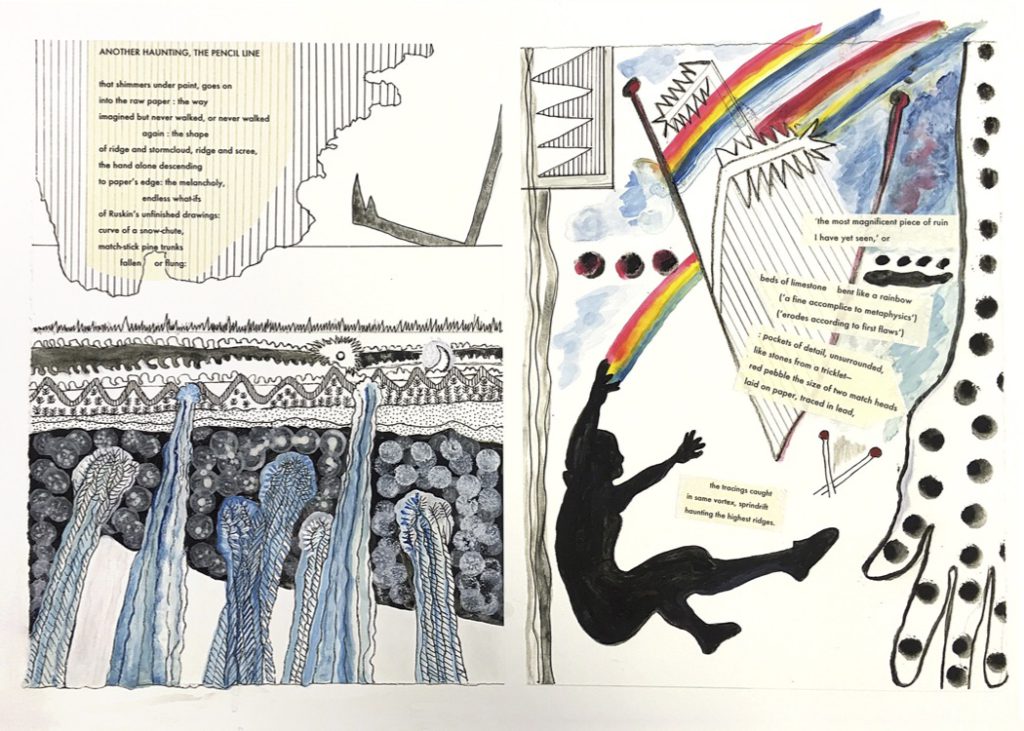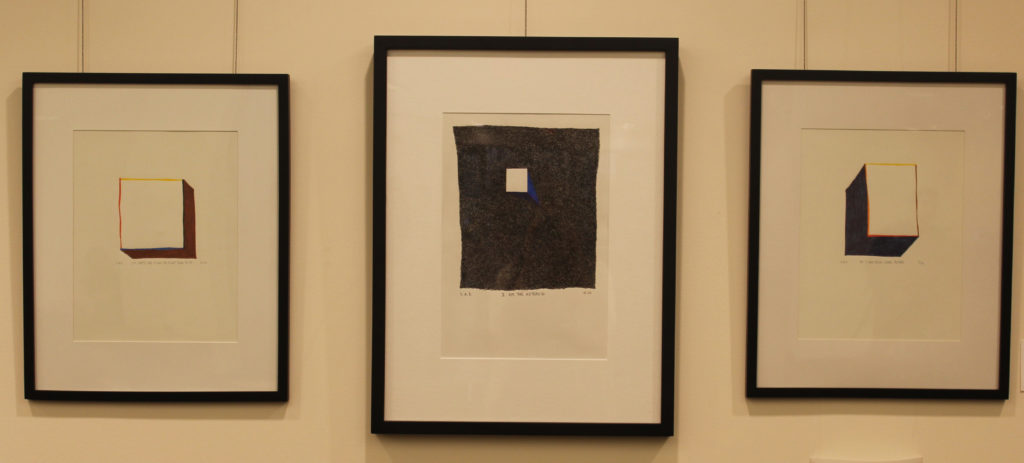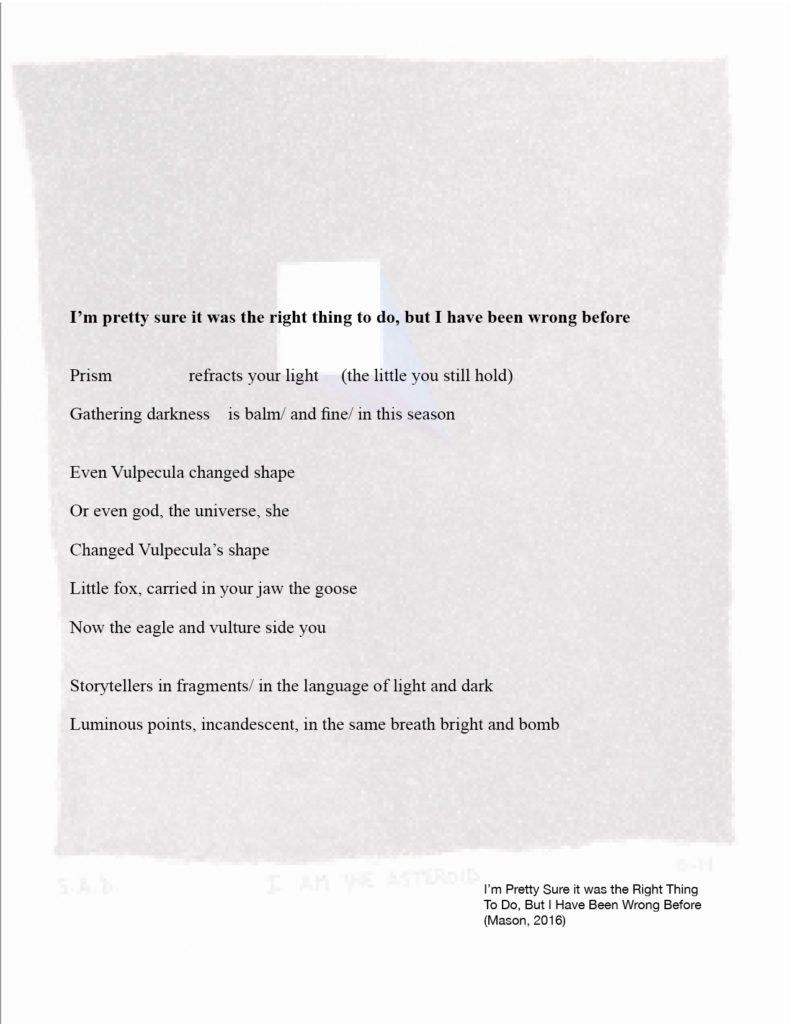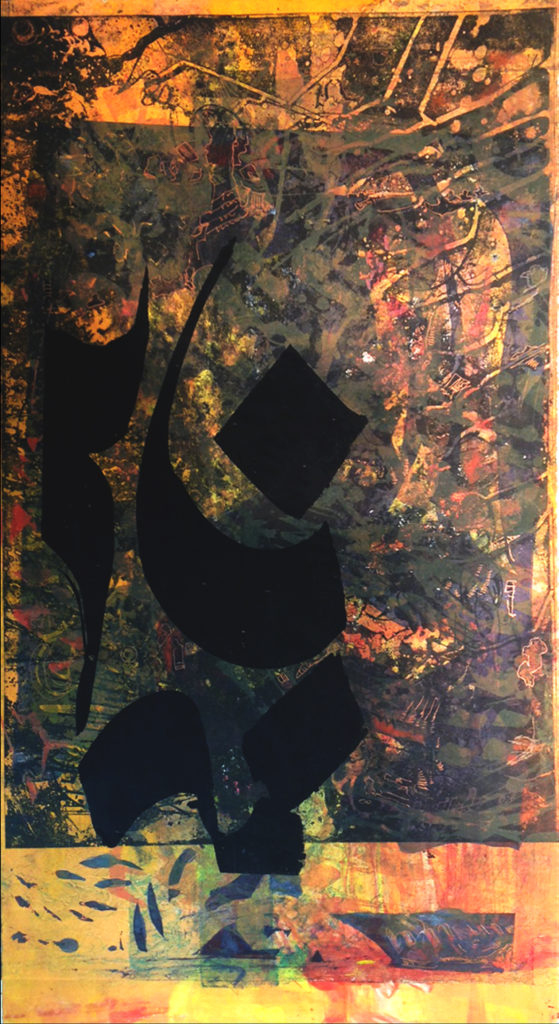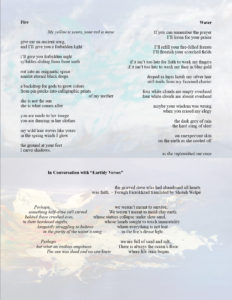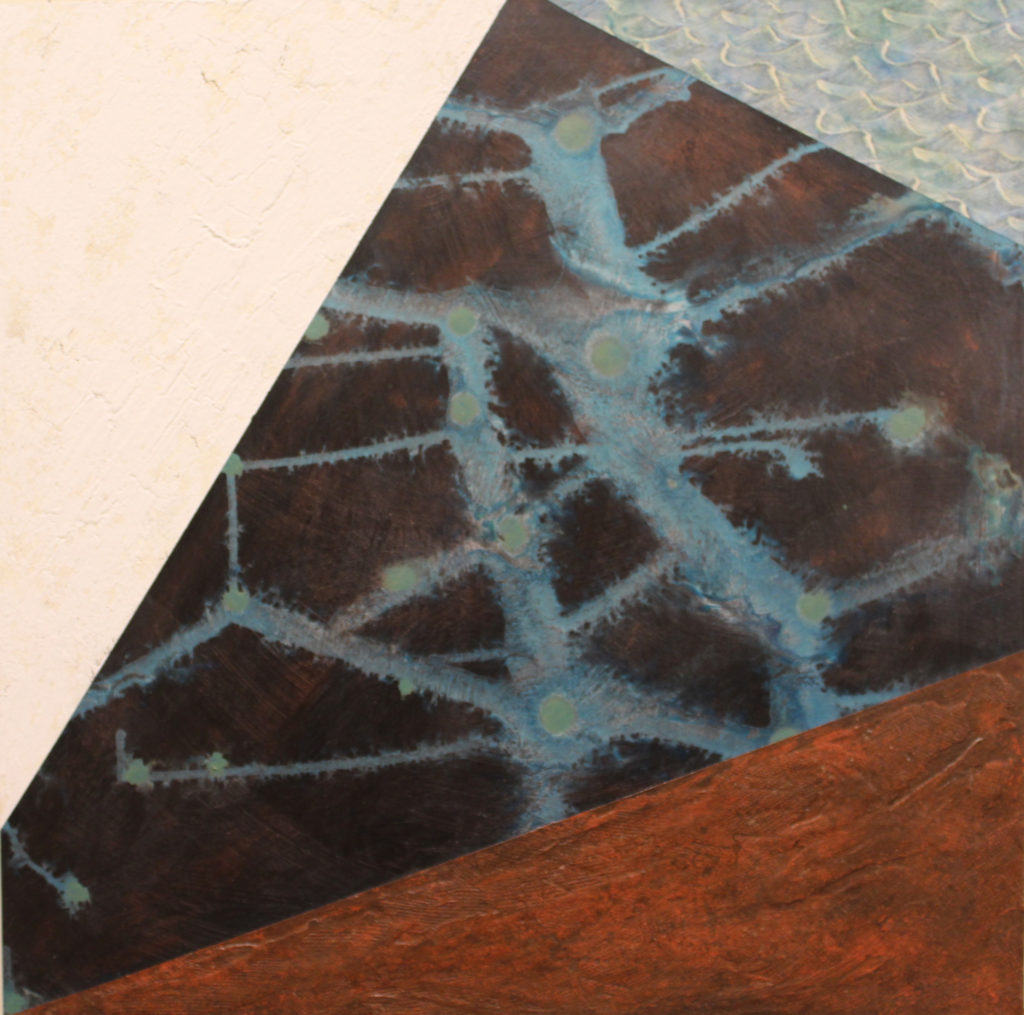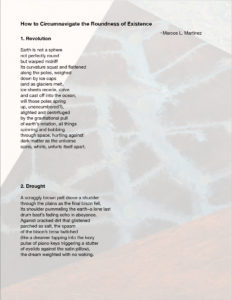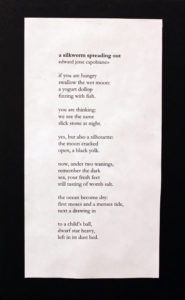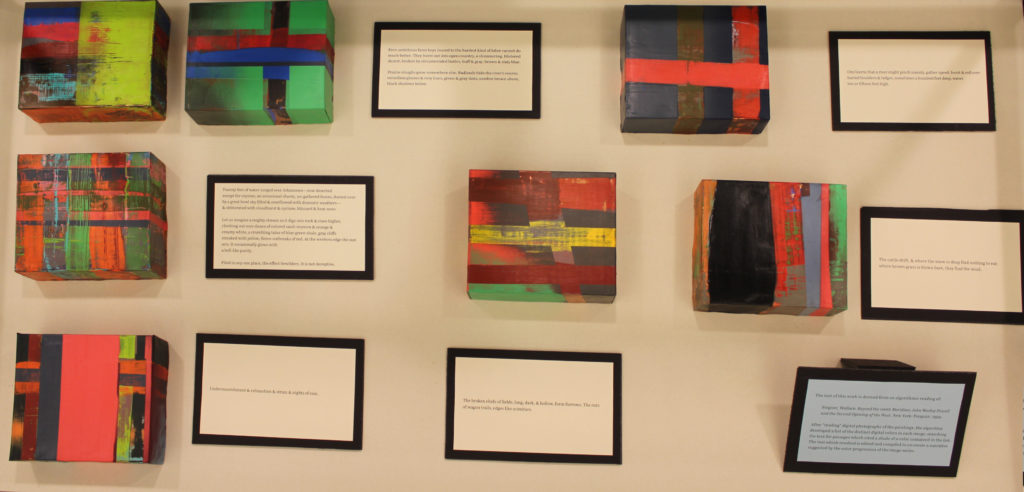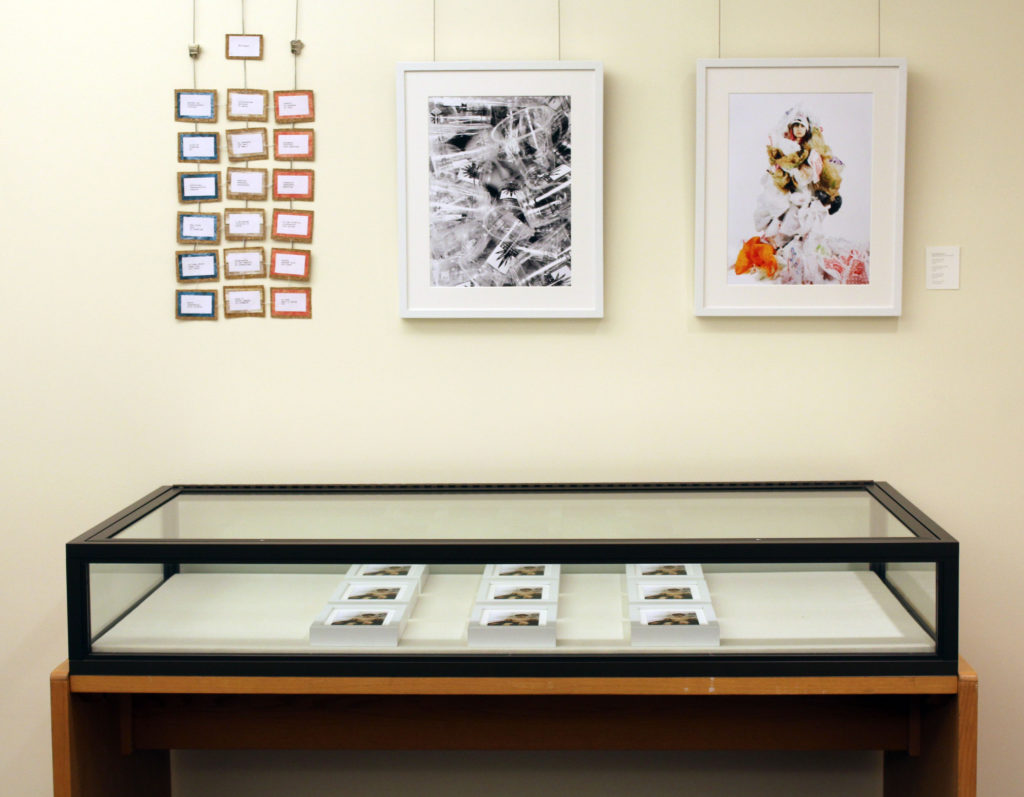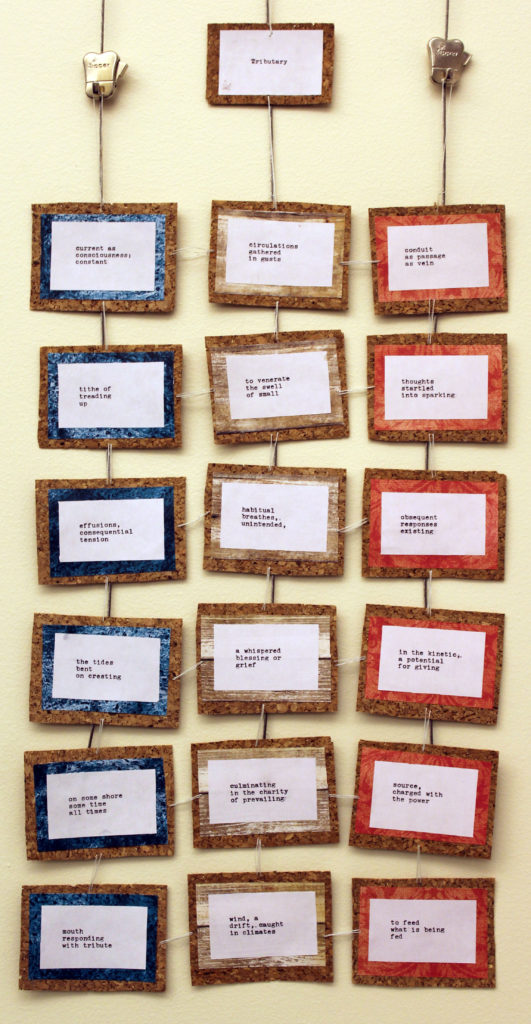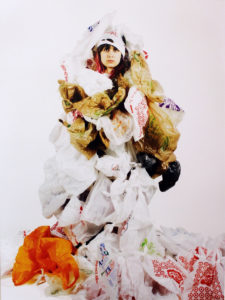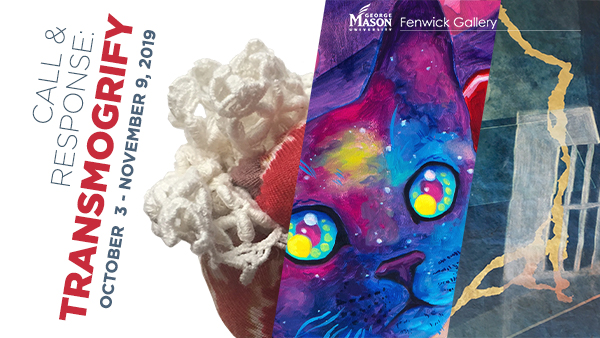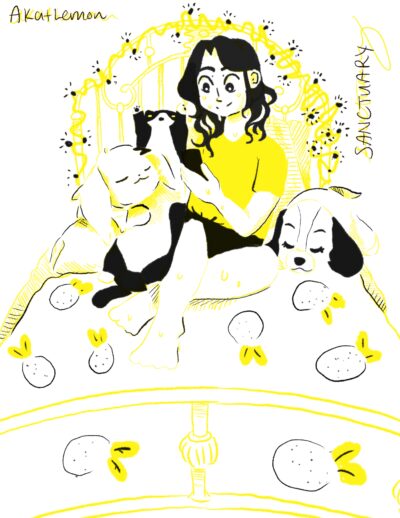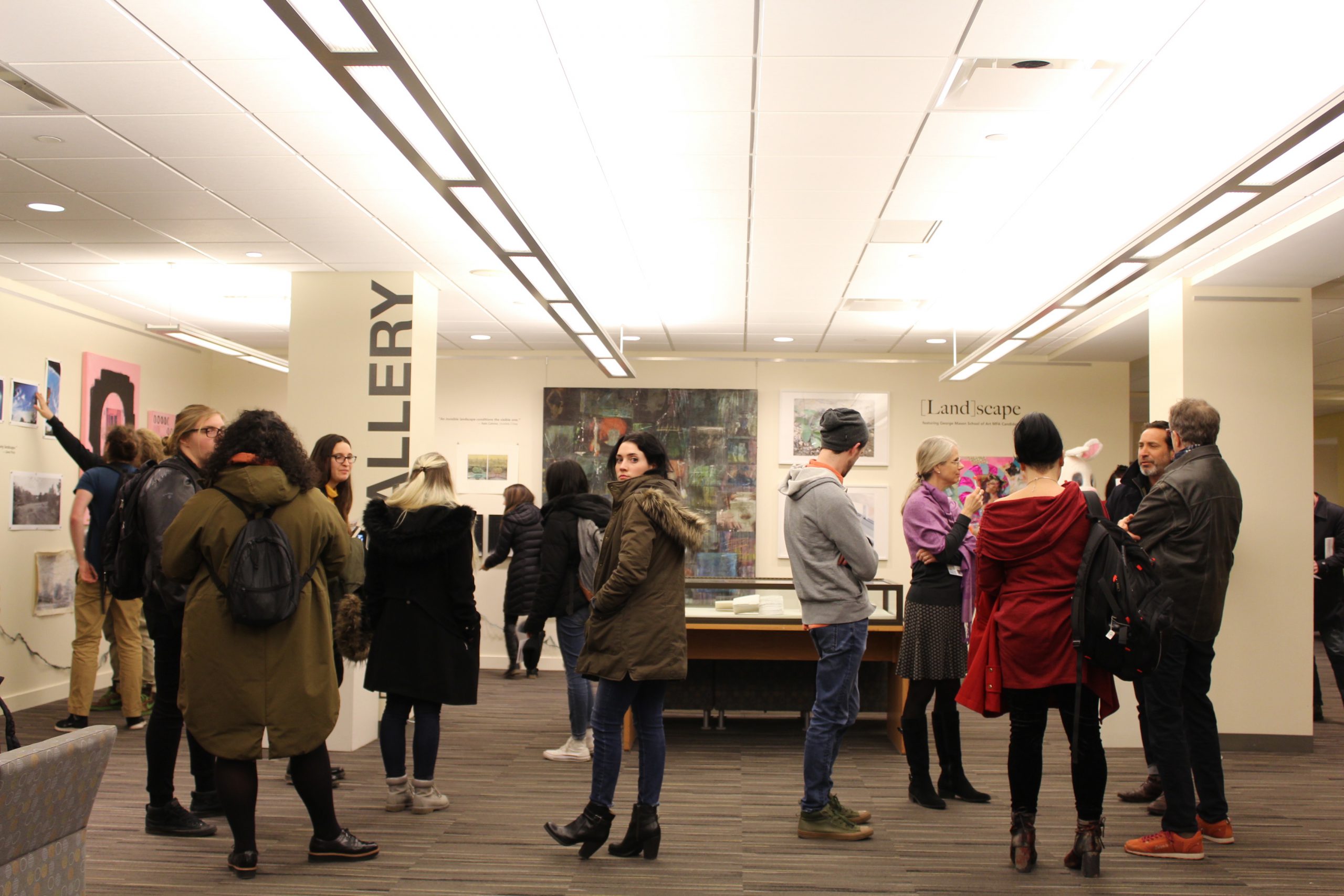September 23 to October 30, 2016
Panel Discussion with Artists & Writers
Wednesday September 28, 3:00-4:15 pm
Fenwick Library, Main Reading Room (2001)
Part of Fall for the Book Festival
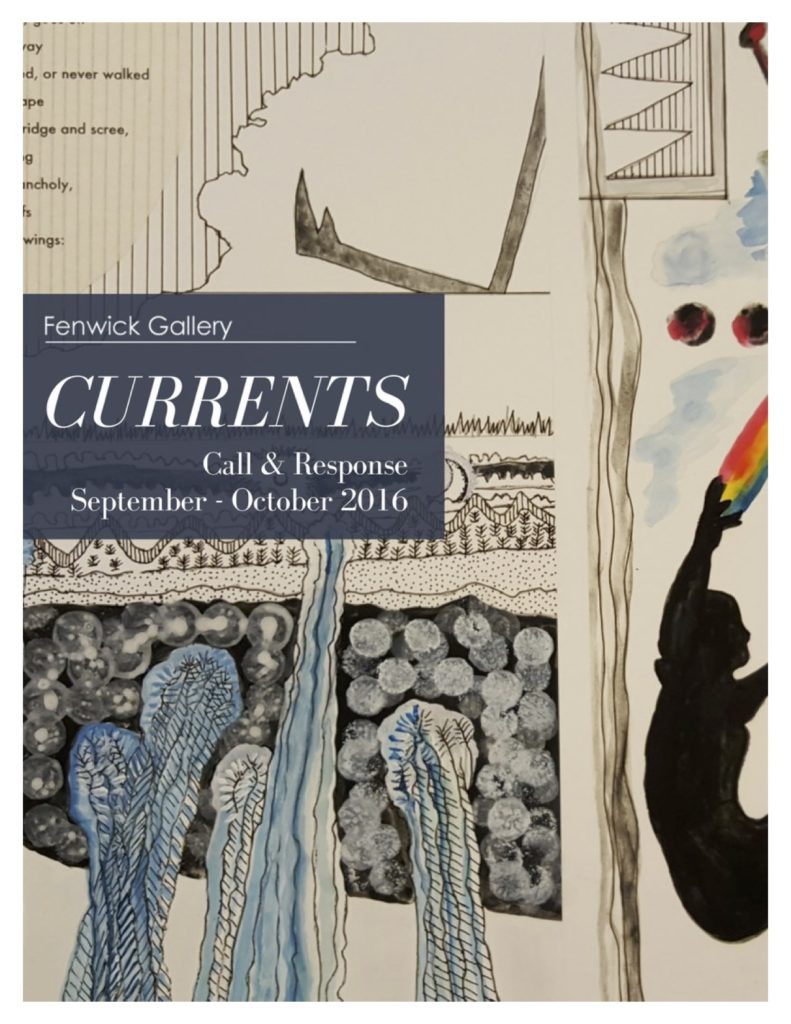
A partnership between the MFA program in creative writing and the School of Art. Presented in collaboration with University Libraries and Fall for the Book festival.
The theme for Call & Response 2016 is CURRENTS, in conversation with the College of Visual and Performing Art’s 100th Meridian Project, an interdisciplinary multimedia arts and science project investigating drought and the American West.
Call & Response: a collaboration between writers and visual artists, in which one calls and one responds. The result is a set of paired works, resonating with each other, demonstrating the interplay of artistic media, and speaking of our times.
In 2009, Susan Tichy and Helen Frederick curated an annual exhibition in collaboration between the MFA program in creative writing and the School of Art. The now annual exhibition has been a themed Call and Response since 2010. The exhibition is up during the Fall for the Book literary festival in September.
Call & Response 2016: CURRENTS is curated by:
Nikki Burgnoli Whipkey– Faculty, Assistant Graduate Programs Coordinator, and Graduate Advisor, School of Art
Mack – GMU Alumnus MFA Poetry; Term Assistant Professor, English; and founding co-editor of Gazing Grain Press
Marcos L. Martínez – GMU Alumnus MFA Fiction; Term Faculty, English; and founding Editor-in-Chief of Stillhouse Press
Anne C. Smith – GMU Alumnus MFA Drawing, Printmaking, and Sculpture; and Teaching Artist, National Gallery
Contributors
Susan Tichy & Helen Frederick
Susan’s home ground is the Colorado Sangre de Cristo range, an 80-mile chain of rocky peaks, nine over 14,000 feet. Snow in the couloirs (high, steep, narrow gullies) avalanches in winter, then lingers through summer. This poem began as a question of experience vs. representation and a portrait of scale within landscape—including our vulnerable bodies vs. a topography in which monumental geological forces are visible…all subject to the present-tense battle between snow and drought. Parenthetical lines are from Robert Macfarlane, who calls us out on our tendency to perceive landscape as metaphor for human ideas.Allusions to walking, paper, falling, vortices, ridges, and bodily pain resonated deeply for Helen. Knowing of the wildfires Susan experiences in Colorado, and putting that knowledge together with her own recent serious personal fall, also haunting, she constructed a visual narrative, teasing marks and symbols across four panels in a new landscape of images, the textures and inner findings of nature upon which all walks emigrate.
Caller: Susan Tichy is the author of five books, most recently Trafficke (Ahsahta Press, 2015), a mixed-form investigation of family, race, and language, spanning from Reformation Scotland to the abolition of slavery in Maryland. She teaches in the BFA & MFA programs at GMU and when not teaching lives in Colorado and writes mountain / geology / walking / drought / wildfire poems—some of which will be collected into her next volume, The Avalanche Path in Summer.Her writing has been widely published in the US and Scotland and recognized by the National Poetry Series, the National Endowment for the Arts, a Chad Walsh Poetry Prize, residencies at Hawthornden Castle International Writers’ Retreat, and numerous other awards.
Responder: Helen Frederick is an internationally known artist whose work has been exhibited at The Phillips Collection in DC, and the Museum of Modern Art, Kyoto, Japan; and is in the collections of the Whitney and Brooklyn Museums in New York, and the National Gallery of Art in DC. Frederick is a Professor Emeritus at George Mason University, Virginia. An active participant in the Washington DC metropolitan area art scene, she has served on boards of various local and national organizations, and national peer review panels. She received the Southern Graphic Council International Printmaker Emeritus Award in recognition of her role as founder of Pyramid Atlantic Art Center. Her private Reading Road Studio, Silver Spring, Maryland provides collaborative opportunities for artists interested in works in and on paper, artist books, and critical conversations about visual literacy.
_________
SpencerDormitzer & Holly Mason
Conceptualization of Spencer Dormitzer’s work mostly comes from an instinctive, trusted place. The true endeavor is carrying out the idea. Scribbling seems so easy; a natural, even simple form of artistic gesture. To carry out an idea through a mere scribble can bring about a strange, and often difficult process, where many emotions rise and fall throughout the completion of a drawing. He considers himself a broken storyteller, using abstract and inanimate forms to ambiguously unite with a title. This connection results to form an abstruse conversation between artist, the artwork and the audience.
Holly Mason’s poem responds to the aesthetic elements of Dormitzer’s art, as well as engaging the narrative(s) found in his titles. These artworks are hand drawn with archival ink. They are not prints or mixed media. The numbers to the right of the title refer to the month and the year the drawing was completed, not the number of an edition.
Caller: Spencer Dormitzer attended the School of the Art Institute of Chicago in 1986 and has been a working artist for over 25 years. Spencer has also worked as studio manager for New York abstractionist David Reed and as an executive producer for the New York Cosmos. Spencer has had over 50 solo and group shows in his career, from such places as Chicago, Illinois, Antwerp, Belgium, Santa Fe, New Mexico and New York City. He also belongs in over 100 private and museum collections. Spencer’s work has been featured in the New Art Examiner, Chicago Tribune, Philadelphia Enquirer, Chicago Reader and New City Chicago Magazine. Currently, Spencer Dormitzer is Director of Joan Hisaoka Healing Arts Gallery, located on U Street NW, Washington, DC.
Responder: Holly Mason received her undergraduate degree from The University of North Carolina at Greensboro. She is currently pursuing her MFA in Poetry at George Mason University. She is the blog editor of So to Speak, a Feminist Literature & Arts Journal. Holly has poems forthcoming in Outlook Springs and Rabbit Catastrophe.
__________
Nahid Navab & Dani Badra
We have created a call-and-response that speaks to the balancing elements of fire and water, the destructive and regenerative properties of these elements, and the traditions associated with these elements in Iranian culture. The artwork is multilayered and complex using the methods of silkscreen, calligraphy, and painting. The poetry responds directly to the artwork, as well as, in response to an Iranian poet, Forugh Farrokhzad’s poem “Earthly Verses”.
Caller: Nahid Navab is an Iranian-American artist with BFA and MFA from George Mason University, School of Art. Her interest is in printmaking, book art and installation. Seasoned world traveler and profoundly influenced by Persian history and literature, Navab blends cultures from across the globe to create artwork infused with a synthesis of heritage and contemporary urban life. Navab works present her belief that art is a conduit for social change. Her works reflect her interest in global unity and women issues.
Responder: Danielle Badra is working on her MFA in Poetry at George Mason University. She is the poetry editor of So To Speak literary and arts journal. Her poems have appeared in Outlook Springs, 45th Parallel, and The California Journal of Poetics. Dialogue with the Dead (Finishing Line Press, 2015) is her first chapbook, a collection of contrapuntal poems in dialogue with her deceased sister.
__________
Marcos L. Martínez & Jessica Kallista
From Jessica Kallista: Fascinated by sensual elements in “How to Circumnavigate the Roundness of Existence” by Marcos L. Martinez, I visualized clearly the work I wanted to create in response. I was particularly taken by the color and texture imagery of earth/ice/ocean, brown/bison/dirt, and polar bears/ivory/fur. The result is a texture driven collage on wood using various papers, as well as latex and acrylic paint. Since the poem is divided into 3 stanzas, it resonated with my obsession with triangles. Inspired by colors in the poem, and also concepts of currents of water, land, and ice, I incorporated blue (Revolution), brown (Drought), and cream/gold (Adaptation) on an acrylic painted background influenced by electrical currents and properties of dendrites.
Responder: Jessica Kallista works as an artist and curator in Northern Virginia. She received her MFA in Creative Writing/Poetry from George Mason University in 2002. In November 2014 she founded Olly Olly, an alternative art space, in Fairfax, Virginia. She also serves as Business Representative for the City of Fairfax Commission on the Arts. Possessed with a frenetic energy to constantly create both literary and visual art she combines the two in collages that employ elements of chance, repetition, and appropriation. Through her work as an artist and curator Jessica seeks to disrupt the isolation of those living in suburbia by creating situations of surprise and instigating dialogue about art, literature, film, decolonization, gender, sexuality, feminism, embodiment, commodity fetishism, creativity, and interconnectivity. Jessica participated as a poet in Call & Response 2014. Jessica’s work has been shown at a variety of venues including Target Gallery, GRACE, The Fridge, Tempus Projects, NoMüNoMü, and the Margaret W. and Joseph L. Fisher Art Gallery.
Caller: Marcos L. Martínez is a native of Brownsville, TX, and is completing his MFA in Fiction at George Mason University. As a Sally Merten Fellow, he has taught creative writing to high school students and adults throughout Northern Virginia. He currently serves as Editor for Stillhouse Press, a collaboration between GMU’s Creative Writing Program and Fall for the Book. Marcos is also a Lambda Literary Fellow. His work has appeared in The Washington Blade, RiverSedge, and Whiskey Island. Current projects include his novel, Embarkations (or, Boating for Beginners), andCleave: The Journals of Caine Lance Calletano, a companion book of poetry told through the voice of his novel’s main character. Marcos lives in Alexandria, VA with his husband of 21 years, Wayne, and their cat Obi.
__________
Helen Zughaib & Jesse Capobianco
From Helen Zughaib: For the past five years, I have been focusing my work on the “Arab Spring” or “Arab Uprisings/Revolutions.” In 2010, I had my first trip back to the Middle East since having been evacuated from Beirut, Lebanon in late 1975. I went to Lebanon, Syria and Jordan. I saw where my father was born in Damascus, Syria, visited the historical places such as Palmiyra, now damaged from war. A few months after I returned to the US, the “Arab Spring” began, initially bringing hope, optimism and potential for change in the Arab world. My work has continued to try to visually record my feelings and emotions on the devolution of the Arab Spring. Using pattern, color, words and pop culture references, in my paintings, I try to keep a sense of optimism and beauty alive in spite of so much loss, sadness and upheaval. I am inspired by traditional embroidery patterns, carpets and old tiles from Damascus that used to grace many homes now destroyed. I focus on women and children, who are the most vulnerable of victims. I also address the more current anti-immigration sentiment that seems ever growing globally. The calls to build walls to keep them out, or to keep them imprisoned in refugee camps. I focus on the bias and negative stereotyping that this wave of refugees, mostly from Syria, seeking safety, has brought to many Western European countries and America. I try to bring attention to the plight of the children fleeing their war-torn countries. I focus on small intimate details of their lives to bring the viewer closer to these issues of immigration and forced evacuation that seem so impossibly large and overwhelming for us to grasp.

Caller: Helen Zughaib was born in Beirut, Lebanon, living mostly in the Middle East and Europe before coming to the United States to study art at Syracuse University, earning her BFA from the College of Visual and Performing Arts. Helen currently lives in Washington, DC, and works full time as an artist. She paints primarily in gouache and ink on board and canvas. More recently, she has worked with wood, shoes and cloth and mixed media installations. Her work has been widely exhibited in galleries and museums in the United States, Europe and Lebanon. Her paintings are included in many private and public collections, including the White House, World Bank, Library of Congress, US Consulate General, Vancouver, Canada, American Embassy in Baghdad, Iraq, the Arab American National Museum in, Michigan, and the DC Art Bank collection. She recently was awarded a grant from the DC Commission on the Arts and Humanities and most recently included in the new Washingtonia Collection. Helen was also invited as artist in residence at George Mason University, Virginia, and Wesley Theological Seminary in Washington, DC.
Responder: Edward Jesse Capobianco grew up in Rhode Island, attended Wheaton College in Illinois, and is working on his MFA in poetry at George Mason. His work has appeared or is forthcoming in Barrelhouse, Rabbit Catastrophe Review, The White Squirrel, Polaris, and other publications. He received the Joseph A. Lohman III Poetry Prize, was a featured poet in the Louisville Portland Poetry Series, and has been honored with a variety of other awards for his poetry and prose.
__________
Josh Whipkey & Doug Luman
The process of reading surrounds us, created by a broad experience of text: whether in books, traffic patterns, or a landscape, humans constantly engage in the process of making meaning from symbols. In the strictest sense, one reads a painting as one might read a text; there are rules for movement dictated by the orientation of shapes and progression of colors; defined boundaries constitute a kind of visual grammar. How do these processes of reading combine to form a system of meaning? Can we apply the rules we learn from one kind of reading to another? In this installation, we ask the question of what it means to illustrate different representations of reading (one experiential and the other computational) to investigate how different texts intersect to share a color grammar, influencing what symbols capture our focus or imagination and what vocabulary they provide.
Caller: Josh Whipkey was born in Connellsville, Pennsylvania in 1975. He received his BFA from Seton Hill College in 1997, and his MFA from The Pennsylvania State University in 2004, both in Painting and Drawing. Josh is also a carpenter, and a self-taught furniture, and cabinet maker.
Responder: Douglas Luman is the Book Reviews Editor for the Found Poetry Review, Head Researcher at appliedpoetics.org, Art Director at Stillhouse Press, Poetry Editor of Phoebe, a book designer, poet, and digital human.
_________
Sarah Laing & Looksorn
From Sarah Laing: I created my piece, Tributary, to reflect through language and form the ways in which currents work in our lives, both interiorly and exteriorly. In our bodies and in our environment, ideas, resources, and nutrients are constantly in relation with each other, one part feeding into another and traveling far beyond the initial spring to introduce meanings and rhythms much greater than ourselves. We may often feel at the mercy of the larger environmental currents, because the energies that shape our world through wind, water, and fuel also shape our bodies, but likewise, we are responsible for the energies we return to the world. We are part of the source, and what we feed in will be fed back to us.
From Looksorn: As human beings, we are the closest to the nature. We consume natural resources, we live on the land, we build houses from wood, we drink water, we need fire from wood, we generate electricity from coal and oil we travel using gasoline. Nature gives us life as we move forward into the future. However we have caused deforestation to get fuel and to build houses. We have created plastic bags for our own convenience without thinking about how it will affect nature. This photographic series, Manufactured Nature, represents what it would be like if nature were to treat us like we are treating her, to call attention to the current environmental situation the earth is facing, caused by humans.
Collaborator: Sarah Laing is a second-year MFA poetry student at George Mason University, and has always regarded writing, particularly the writing of poetry, as her true vocation and passion, in spite of various other interests and responsibilities, including her full time position as a mother to a beautiful little boy named Cayden, and a second child due in March 2017. Sarah is excited to have been asked to participate in Currents, as most of her work centers around the relationship between self and environment, and the ways in which consciousness is manifested in both the rhythms of language and of nature.
Collaborator: Looksorn was born in Bangkok Thailand; she graduated from George Mason University in 2016 with a Bachelor of Fine Arts concentration in Photography. She is now based in Washington metropolis area and in Thailand during summer. She was learning new culture when she first got to the United States as a street photographer. Her interest in snapshot has evolved into documentary photography and portrait later. Looksorn is now working on a long term project observing bribe culture in Thailand.
